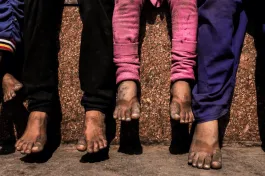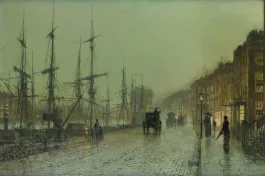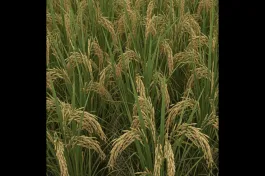In the midst of the Second World War, after Burma fell to Japan in 1942, the princely state of Travancore in south India lost access to its key source of rice. In comparison to the neighbouring state of Cochin, Travancore acted belatedly and without adequate urgency to secure food from other areas.
The consequences of this shortage and its subsequent mismanagement were profound. They contributed to an estimated 90,000 deaths and the loss of legitimacy of an already unstable and unpopular regime.
This event, contemporaneous with the more ruinous Bengal Famine, took place in one of India’s richest princely states, often seen as a model of governance. It has been largely forgotten. Yet, the food scarcity of the period became a rallying point and material condition that the communists were able to use both to legitimise their cause and win converts. It enabled them to launch a major uprising and helped lay the foundations for their enduring presence in Kerala.
Food shortage and its mismanagement
The long-term driver of rice dependence on Burma was Travancore’s transformation into a cash crop economy from the 19th century onwards.
Policies granting security of tenure and tax concessions on its land allowed an attractive small peasant agriculture to take root. In parallel, European contact in the second half of the 19th century contributed to the development of markets for export. The state also had a large plantation sector, especially for tea, cardamom, and rubber. By the 1920s, Travancore was exporting millions of pounds of tea and rubber and millions of yards of coir mats.
The developments disrupted regional self-sufficiency. It left Travancore vulnerable to the vicissitudes of global markets, of the sort that followed the fall of Burma.
Export revenues more than paid for expanding import requirements. They also funded state-facilitated industrialisation centred on agro-processing. However, the developments disrupted regional self-sufficiency. It left Travancore vulnerable to the vicissitudes of global markets, of the sort that followed the fall of Burma.
By late 1942, Travancore was experiencing a crucial shortage of food. In the Indian government’s order of priority for food aid, Travancore and Cochin came a distant second after Bengal. Even within that allotment, only a fraction of the stocks promised from surplus areas arrived. The dispatches of rice were further reduced over great distances they travelled on the already overburdened railways, which created opportunities for pilferage along the way.

To remedy the crisis, Travancore pursued its local version of the nationwide Grow More Food Scheme. Through this, it sought to switch over from cultivating cash to food crops, expand the land area under cultivation, increase irrigation, and use better seeds to improve agricultural yields. But unlike other states, Travancore was already near the frontier of cultivable land.
More consequentially, the government began to regulate and oversee food procurement and distribution. This was a reactive process of trial and error. It responded to dishonest behaviour by government employees, landowners unwilling to let go of excess stocks of food, and unscrupulous merchants who aimed to sell grain to the highest bidder.
Travancore initially required merchants to secure permits for trading and provide the government with information about the purchase and sale of stocks. However, this effort did little to mitigate price increases in rice. Next, the government experimented with introducing designated grain purchasing officers and invested them with legal sanction to purchase food from landowners holding excess stocks at specified prices. This created an incentive for landowners to lie about their stocks. Officers themselves had varying methods for determining excess. This basis for determining excess stocks was then substituted by a measure based on acreage. But land yields differed by plot, so the government shifted to measurement based on land rent, which in turn corresponded to yield.
Although it was smaller and closer to a major port, Cochin’s leadership better understood the gravity of the problem.
When every other alternative had been exhausted and found inadequate, the government of Travancore took over every aspect of food procurement and distribution. But the amount of the ration the state could offer was only about eight ounces (227 g), compared with 21.3 ounces in Madras and 24.3 ounces in Bombay. This might have been able to sustain life, but not healthy living.
Travancore’s comparative mismanagement of the food shortage becomes apparent when compared to neighbouring Cochin. Although it was smaller and closer to a major port, Cochin’s leadership better understood the gravity of the problem. From the very beginning of the shortage, it instituted a single price of food. Thus, the problem of cheaper rice going to those with greater willingness to pay could be avoided. Procurement was based on settlement yields rather than acreage. Village panchayats were introduced earlier to help determine localised requirements of stock from landowners. Rationing was introduced a full year before Travancore. “Cochin restaurants” were introduced with more palatable meals made from rice alternatives to encourage people to adjust their food habits.
'The desperate mood'
What do we mean by famine, and can we call Travancore’s experience one of famine? Some estimates call anything over 10,000 deaths a famine; others any event that leads to a daily excess mortality rate of over 1 in 10,000 (Howe and Devereux 2004). The Famine Enquiry Commission Report published in 1945 did not have official estimates and did not consider these events to constitute famine (Government of India 1945). But they were also not aware of the casualties.
The only reckoning we have of famine deaths in Travancore between 1942–44 is based on parish records of the Church Missionary Society, used by K.G. Sivaswamy of the Servants of India Society to arrive at a figure of approximately 90,000 deaths.
This estimate is crude. Sivaswamy's calculations did not adjust for changes in the composition of the population. But it is all that we have. Irrespective of the precise numbers, various parties considered the events to constitute a famine.
Ration officers sold rice on the black market or at inflated prices to the poor and enriched themselves.
The effects of Travancore’s management of the food shortage varied across class, caste, and space. Fictionalised accounts and subsequent disproportionate assets cases suggested that ration officers sold rice on the black market or at inflated prices to the poor and enriched themselves. For the poor, malnutrition led to greater vulnerability. The reduction of immunity left Travancoreans more susceptible to smallpox and cholera.
Protruding ribs, swollen stomachs, and stick-like arms became a common sight. The weight at birth of children born between March 1943 and September 1944 declined by eight ounces (227 g). Conditions worsened as one moved away from urban areas.
Some 12,000 people migrated north to the jungles of Malabar in the neighbouring Madras presidency, where they sought to cultivate land for food crops. Moving to the jungle carried risks: some could not successfully bring land under cultivation and had to return. Others died of malaria. Adjusting diets to the produce of the land could lead to an overconsumption of carbohydrates and deficiencies in fish and coconuts. The resulting anaemia and scabies increased mortality rates.
Those who could not leave experienced worse undernutrition and were forced to rely more heavily on rice substitutes like tapioca. An excess of this starch in the diet slowed bone growth in children. Protein deficits in diets led to oedema and kwashiorkor.
The former was the most common experience. For a person experiencing oedema, swelling begins in the abdomen and spreads through the body, stretching the skin. Blood pressure drops, corneas turn red and sore, and aches and pains develop across the body. A craving for carbohydrates and salt develops, accompanied by uncontrollable diarrhoea. Then, the victims move from depression, to irritation, to unconsciousness.
"Beg, bribe, borrow, steal, do anything you like so you may live! – This becomes the desperate mood”
The communist leader E.M.S. Namboodiripad, who went on to become the first chief minister of Kerala, spoke of how under these conditions, notions of morality were replaced by survival instincts: “Self-respect and fellow-feeling disappear in the face of hunger. Beg, bribe, borrow, steal, do anything you like so you may live! – This becomes the desperate mood” (Namboodiripad 1943).
But this story is not one merely of disempowerment and of death that were forgotten. Political developments were underway.
Political denouement
The war provided a ruse for Travancore’s autocratic diwan C.P. Ramaswamy Aiyar to keep a lid on dissent and prevent the transmission of information about the gravity of the situation in the state. In regular times, he suppressed the press and feared responsible self-government. With expanded powers from the Defence of Travancore Rules, he was able to arrest politicians for sedition if they exposed the food situation. Press communiques warned against subversive activities. The state police hired gangs to disrupt meetings held by dissidents. By surrounding himself with sycophants, Ramaswamy Aiyar had also driven his subordinates into silence.
Despite the repression, the worsening food situation created the conditions for successful communist activity and the eclipse of princely rule in Travancore. It also shaped the growing conceptualisation of a united state of Kerala out of the politically divided Malayalam-speaking areas of south India: the princely states of Cochin and Travancore, and British Indian Malabar.

Politics in the theocratic state of Travancore had developed in a distinct but connected fashion to the provinces of British India. Early-20th-century movements focused on caste reform. Ezhavas, Dalits, Christians, and Muslims came together to contest Brahmin and Nair domination of government employment. The state resisted the demands of progressive politics. Reforms amounted to reversible, targeted mitigations of popular pressure that proceeded from the reordering of social and economic relations.
By the 1930s, shaped by mass nationalism in British India, political activity in Travancore began to be concerned with the advent of responsible self-government in the future. Travancore introduced a largely hollow bicameral legislature with limited franchise, marking out special quotas for Muslims, non-Syrian Christians, and Ezhavas.
The left wing of the Congress and the communists attracted a considerable following by this time, particularly amongst coir workers in the coastal Ambalappuzha and Shertallai districts. They helped stage a major general strike and oversaw a local Civil Disobedience movement in 1938, which was brutally suppressed. Building on these developments, a Travancore branch of the communist party was founded in 1940.
The war proved to be a boon for the communists. When the Soviets entered the war in 1942 on the side of the British, the communists dropped their opposition. By contrast, the Congress staged the Quit India Movement this year, and most major leaders were jailed. Freer from the threat of arrests, the communists organised workers and peasants to increase food production, formed feeding centres for the poor, and helped the government get acreage and yield statistics of farms.
The communists also conducted night classes to educate children and potential party workers in their ideology and train them in guerilla warfare. They focused their efforts on factory workers and agricultural labourers. By the end of the war, they had about 45,000 workers in Travancore. Most of these were of lower-caste and Dalit backgrounds.
The cessation of hostilities would not have been noticed much by the average Travancorean. Food scarcity continued, and prices kept up their ascent. Migration to the jungles continued. Reduced demand for coir from the United States after the end of the war threw coir workers out of jobs.
Unlike in Malabar, where the Congress had a mass following, in Travancore it was the Communists who took the lead in organising labour strikes, food rallies, and student actions.
In this environment, the communists persisted in tying food-related agitation to ideological concerns.
In late July 1946, Travancore communists raised a jatha (organised march) of 2,000 people, shouting food slogans and Inquilab in Alleppey to protest against rising prices. Unlike in Malabar, where the Congress had a mass following, in Travancore it was the communists who took the lead in organising labour strikes, food rallies, and student actions.
The activism of this period dovetailed with the idea of Aikiya Keralam (United Kerala), free of princely or imperial rule and governed by democracy. The communists bitterly opposed Ramaswamy Aiyar’s schemes for Travancore’s political future. Recognising that an independent nation-state was an unlikely outcome, he proposed what he called an “American Model,” Travancore would become a part of a federation nominally joined to an Indian Union. There would be universal suffrage, but a permanently ensconced executive would be appointed by the maharaja. In response, the communists raised the slogan “Throw the American Model in the Arabian Sea!” (Jeffrey, 1977).
Subsequent tensions culminated in what came to be known as the Punnapra-Vayalar revolt. On 22 October 1946, a general strike was inaugurated. Two days later, a clash between the police and workers broke out, killing four policemen. The next day, martial law was declared in Shertallai and Alleppey. Ramaswamy Aiyar took over the military and raided worker camps. In motor boats, a military detachment operated the peninsular village of Vayalar and opened fire on thousands of workers and killed hundreds. This was the first working-class revolt against the government in Indian history. Months after the uprising, the diwan left his job, and Travancore acceded to the Indian Union.
The Punnapra-Vayalar revolt came to be the stuff of communist lore. It helped the Communists consolidate their political base. On 1 November 1956, the united state of Kerala came into being. Assembly elections in the following year brought the world’s first democratically elected communist government to power.
Conclusion
What accounts for the comparatively greater attention to Bengal over Travancore in famine historiography and popular memory? The scale of the Bengal famine was much greater than Travancore. In Bengal, the editor of Calcutta’s widely and internationally circulated The Statesman newspaper began to write about the famine from August 1943. No comparable publication did the same to expose the events in Travancore; all possibly offensive literature was banned. Travancoreans migrated to rural areas while Bengalis came to the metropolis, where others could perceive their suffering. And Bengal’s importance to colonial India dwarfed that of Travancore.
Indeed, the devastation of the Bengal famine has overshadowed the impact of food shortage, hunger, and starvation in other parts of the subcontinent during the Second World War. Food deficits arose across the Northwest Frontier Province, Bihar, UP, and Bombay and Madras Presidencies.
But it would be wrong to say that the Travancore events were forgotten because they were not important. Far from it.
Unlike in the other areas of the former Madras Presidency, where ration shops were disbanded after the war, they were consolidated and expanded in what became Kerala.
Communism and food policy continued to be related in postcolonial Kerala. Within a year of taking office in 1957, the communist government lifted taxes on foodstuffs and created policies to lower rice prices. The state took over the cultivation of rice in the fertile Kuttanad region.
Although Kerala is not without its problems, it has the country’s best public distribution system today. It operates a two-level system with a widespread network of ration and fair price shops. Unlike in the other areas of the former Madras presidency, where ration shops were disbanded after the war, they were consolidated and expanded in what became Kerala. The communists continue to perform well electorally in what became Alappuzha district, which incorporated Ambalappuzha and Shertalai and included the sites of the Punnapra-Vayalar uprising.
Restoring Travancore’s forgotten famine of 1943 to our memory reminds us that hunger was a constitutive experience of war in regions across the subcontinent, one with multiple histories. It shows us how positive political change can follow from the most devastating of events. It illuminates part of a broader story of how one remarkable region has defied some of the dominant trends that have characterised the Indian nation-state’s chequered history.
(This essay is adapted from “A Forgotten Famine of ’43? Travancore’s Muffled ‘Cry of Distress,’” part of the September 2023 special issue of Modern Asian Studies on “Rethinking the Second World War in South Asia,” edited by Isabel Huacuja Alonso and Andrew Amstutz.)
Aditya Balasubramanian is a senior lecturer in history at Australian National University and the author of Toward a Free Economy: Swatantra and Opposition Politics in Democratic India (Princeton University Press, 2023).









